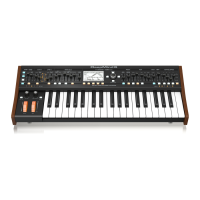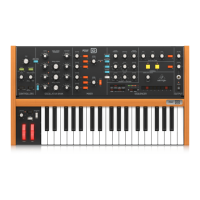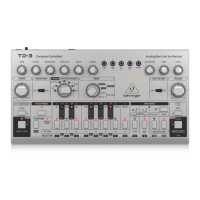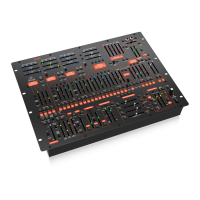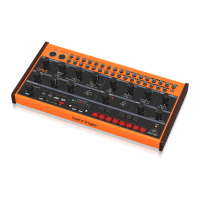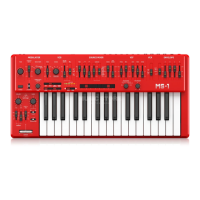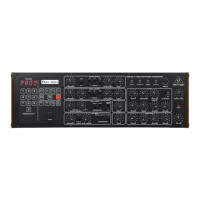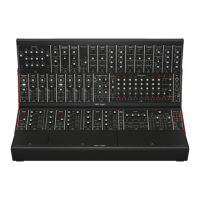98 DeepMind 12 User Manual
Rack Amplier
Modelled after the Tech 21 SansAmp, the Stereo / Dual Guitar Amp simulates the
sound of plugging into a real guitar amp. From shimmering cleans to saturated
crunch, the Stereo / Dual Guitar Amp allows an electric guitar player to sound
great without using an amp on stage. The PREAMP knob adjusts the amount of
input gain prior to the band-specic distortion adjustment. BUZZ adjusts the
low-end breakup, PUNCH adjusts the midrange distortion, and CRUNCH tailors
the high-frequency content and distortion for smooth or cutting notes. The DRIVE
knob simulates the amount of power amp distortion from a tube amp. The LOW
and HIGH knobs allow EQ adjustment independent of distortion content, and the
overall output is controlled by the LEVEL knob. There are 11 CABINET emulations
which can be selected using the CAB parameter. The CABINET simulation can also
be bypassed which allows the eect to function like a boost or distortion pedal.
Edison EX1
The EDISON EX1+ is a remarkably eective tool that allows manipulation of the
stereo eld. The eect oers stereo and mid/side input and output and a phase
correlation meter. Exaggerate the stereo eld with the ST SPREAD knob and
adjust the ratio of mono to stereo content with the BALANCE knob. The CENTER
DIST knob allows the mono content to be panned. Compensate for level changes
with the OUTPUT GAIN knob.
Auto-Pan
Auto-pan creates an up and down volume change at a constant and even tempo
just like the guitar amps of yesteryear. Use the Auto-pan to add a unique “surf-
music” texture.
SPEED adjusts the LFO rate and DEPTH sets the amount of modulation. PHASE
can be used to set an LFO phase dierence between the left and right channel,
which can be used for panning eects. The WAVE knob blends the LFO waveform
between triangular and square shape. The signal envelope, shaped by ATTACK,
HOLD and RELEASE, can be used to modulate the LFO speed (ENV SPEED) and the
LFO modulation depth (ENV DEPTH).
NoiseGate
The Noise Gate not only handles the duties of a traditional version, but also oers
enhanced "Transient Accenting" characteristics to gated signals. Enhance the
attack envelope beyond merely opening the gate, and provide up to 12 dB of
additional transient energy to percussive programs. In many cases the DN265's
control over transients may prove to be a viable alternate to EQ.
Attack is exponential which means it can be set extremely fast to reduce signal
loss at the start of sounds while remaining sonically transparent - no clicks.
Gate release is reverse exponential so it can be set relatively fast and blend in
seamlessly with the natural decay of the material.
Delay
Stereo Delay provides independent control of left and right delay (echo) times
and features high and low pass lters for enhanced tone shaping of the delayed
signals. Use the Stereo Delay to give your mono signals a wide presence in the
stereo eld.
The MIX control lets you blend the source signal and the delayed signal.
TIMEadjusts the master delay time up to three seconds. LO CUT adjusts the low
frequency cut, allowing lower frequencies to remain unaected by the delay.
HI CUT adjusts the high frequency cut, allowing higher frequencies to remain
unaected by the delay. FACTOR L sets the delay on the left channel to rhythmic
fractions of the master delay time. FACTOR R sets the delay on the right channel
to rhythmic fractions of the master delay time. OFFSET LR adds a delay dierence
between the left and right delayed signals. The FEED LO CUT/HI CUT adjusts lters
in the feedback paths. FEED L and FEED R control the amount of feedback for
the left and right channels. MODE sets the feedback mode: Mode ST sets normal
feedback for both channels, X crosses feedbacks between left and right channels.
M creates a mono mix within the feedback chain. P-P sets up a Ping-Pong delay.
(Note: the FEED R control is disabled in this mode.)
3-Tap Delay
Sometimes called a 3-Tap Delay, the Triple Delay provides three delay stages with
independent frequency, gain, and pan controls. Create time-based echo eects
with the Triple Delay to increase the sense of stereo separation.
TIME sets the master delay time, which is also the delay time for the rst stage.
GAIN T sets the gain level of the rst stage of the delay. BASE T sets the position
of the rst delay stage in the stereo eld. X-FEEDindicates that stereo cross-
feedback of the delays is active. FEEDBACK adjusts the amount of feedback.
FACTOR A controls the amount of delay time in the second stage of the delay.
GAIN A controls the gain level of the second delay stage. PAN A sets the position
of the second delay stage in the stereo eld. FACTOR B controls the amount of
delay time in the third stage of the delay. GAINB controls the gain level of the
third delay stage. PAN B sets the position of the third gain stage in the stereo
eld.
4-Tap Delay
The 4-Tap Delay provides 4 stages of delay with independently adjustable gain
and rate, allowing unique syncopation to be created in the layered repeats.
TIME sets the master delay time, which is also the delay time for the rst stage.
GAIN sets the gain for the rst stage. SPREAD positions the rst delay stage in
the stereo eld. A global FEEDBACK adjustment is also available. FACTOR A, B and
C adjust the delay rate relative to the global TIME setting for the 2nd, 3rd and
4th stages respectively. Each stage also has its own GAIN adjustment. X-FEED
indicates that stereo cross-feedback of the delays is active.

